C/2001 Q4 NEAT page



C/2001 Q4 NEAT 2 degree wide field images.
Left: May 7th 2004 at 10:20UT.
10x30 second exposures.
Note star clusters M47 (middle) and M48 (right) in the
field of view.
Middle: May 8th at 09:30UT. 10x30second exposures.
The bright star to the left of the comet is Alpha Monocerotis.
Right: 30x30second exposures stacked on the comet and unsharp masked to
draw out structure in the tail.


C/2001 Q4 NEAT, May 7th 2004 at 11:10UT.
Left:
15x15 sec exposures through C11 at f/3.3.
Right: Larsen-Sekania filter
applied.


C/2001 Q4 NEAT, May 6th 2004 at 11:50UT.
Left:
13x15 sec exposures through C11 at f/3.3, hazy conditions.
Right: Larsen-Sekania filter
applied.
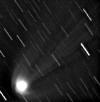
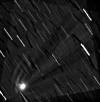
C/2001 Q4 NEAT, May 4th 2004 at 10:32UT.
Left:
30x10 second exposures.
Right: Larsen-Sekania filter applied

2001 Q4 NEAT, April 26th 2004 at 11:20UT
25x20second exposures, flat fielded
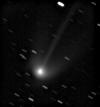
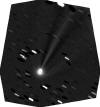
C/2001 Q4 NEAT CCD image, April 21st 2004 at 10:15UT
Left:
27x20second exposures taken through a Celestron C11.
Right:
Same photo with the Larsen-Sekania filter applied.

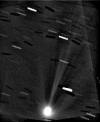
Left:
C/2001 Q4 NEAT CCD image, April 20th 2004 at 10:40UT
30x30second exposures taken through a Celestron C11.
Flat fielded and gauss equalised to draw out details around the
nucleus.
Right:
Same photo with the Larsen-Sekania filter applied. This enhances the jets and
shells around the nucleus.
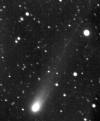
C/2001 Q4 NEAT wide field image taken on April 20th at 11:05 UT.
30x30 second exposures through a 135mm Hannimex lens at f/5.6.
Field of View 1.8x1.5 degrees. The comet appears edge-on to the
Earth.

C/2001 Q4 NEAT. Taken on April 17th at 12:28 UT.
10x30 second exposures through a 135mm Hannimex lens at f/5.6 piggybacked on a
C11. Field of View 2x2.5 degrees. Note the short broad dust tail and the long
thin ion tail. Coma size is
12 arcminutes in diameter which translates to 350,000kms across.
Note galaxy NGC 1313 at top right of field.

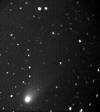
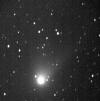

CCD images on Oct 15th, Dec 27th 2003, Jan 23rd, March 12th 2004.
C/2001 Q4 NEAT was discovered on August 21st 2001 by the Near Earth Asteroid
Team at a distance of 10 astronomical units from the Sun (1AU=distance from
earth to Sun)
This comet was predominantly a Southern Hemisphere object until May 2004.
Closest approach to the Earth occurred on May 7th 2004 at 0.32 AU (48 million kms). At this time, the comet peaked
at about magnitude 2.8 and was prominently visible
high in the evening sky for Southern Hemisphere observers in the constellation
of Puppis.
Closest approach to the Sun occured on May 15th 2004 at 0.96 AU (144 million kms) in Cancer, very close to the beehive cluster M44.
For southern hemisphere viewers, from May 18th, comet LINEAR C/2002 T7 joined
NEAT in the evening sky.
This appears to be NEAT's first and only passage through the inner solar
system.



















